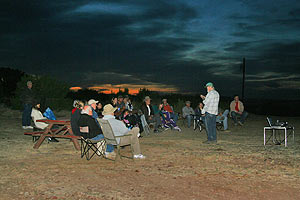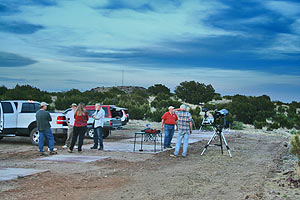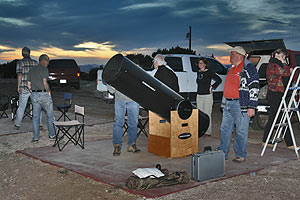Alpine Star Party
Paul Derrick presented a slide show entitled “Constellations with a Little Imagination.” Using photos of constellations (imaginary pictures in the sky created by the ancients using the brighter stars) and modern artists’ conceptions of these pictures, he demonstrated how all constellations require at least some imagination, many require a lot of imagination, and some just don’t resemble anything at all.
”This area has some of the darkest skies in the U.S. — great for naked-eye, binocular and telescope viewing. It’s no wonder that stargazers like me are willing to drive hundreds, even thousands, of miles to enjoy these views.” “Even with tonight’s partly cloudy skies, I can see how the Astronomy Village section of Sierra la Rana is a stargazer’s mecca — a small hill blocking the minimal light from nearby Alpine to the north and a dazzling unobstructed totally dark view to the south. I look forward to coming back for many nights of superb observing.” “And not incidentally, my birder wife regards the Davis Mountains-Big Bend area as one of her favorite birding locations.
Paul Derrick
”Children Are Stardust Astronomy Village Telescope Pads with Bullfrog Mountain in the BackgroundDriving toward Astronomy Village in the upper reaches of the Sierra la Rana real estate development on the foothills of Bullfrog Mountain (elevation 5,400 feet), a wandering SUV flagged down another vehicle heading to the First Annual Dark Star Party and asked, “Do you know where the Dark Sky Party is?” On arriving at the newly graded road and parking lot at the party site, a mother and young daughter left their SUV and joined 30 other stargazers for a “show and tell” dark sky party. Mr. Paul Derrick, author of “A Beginner’s Guide to Learning the Night Sky,” began the party with an outdoor slide show, “Star Constellations with a Little Imagination.” By engaging the children in questions and answers during his slide presentation, Mr. Derrick also engaged the attending adults. Beginning with a more easily imagined picture full of depth and stars, Mr. Derrick asked, “Does anyone know this constellation?” One of the dozen or so children in attendance whispered under her breath, “Big Dipper!” The 30 minute talk progressed through additional constellations, each image requiring more imagination than the last to envision. After Mr. Derrick’s initial presentation the audience moved to 3 telescopes anchored on concrete platforms and ranging from 8″ to 15″ aperture as provided by local and out of town amateur astronomers. Stars were sighted through the clouds and the rings of planet Saturn were clearly discernable in the telescope of Mr. Alan Dean of Houston, TX. By 10:30PM the serious astronomers were still game for the viewing, but the children with parents in tow were headed down mountain for home and bedtime. Next year with dark and clear skies, the stardust children will again per chance whisper in wonder and new knowledge, “That’s the Big Dipper,” and “Wow, there are the rings of Saturn!” The Dark Sky Party of Alpine, TX is hosted by Sierra la Rana land development and Vice-President of Development, Mr. Gil Bartee. The International Dark Sky Association supports Alpine’s Dark Sky initiative and the protection of worldwide night time vistas as valuable to human tradition and as beneficial to wildlife.
Ben Franklin Rummerfield
”Three amateur astronomers brought their scopes out to the SLR dark site. Two of the scopes were computerized Schmidt-Cassegrain models, with 6″ and 10″ mirrors. The third scope was a manual scope, but the lack of computer power was more than offset by the larger size – this scope had a mirror 15″ in diameter. While the clouds were largely uncooperative for our evening’s viewing, we were able to find a few gems through either the thinnest layers of the high clouds or through the occasional hole in the clouds. Many of the stars you see in the night sky are actually “double stars” that appear as a single point of light to the naked eye, but are “split” when viewed through a telescope. One of the sky’s most glorious doubles is a star by the name of Cor Carloli, in the constellation Canes Venatici. This star was beautifully split into separate blue and orange components, which were clearly visible through the eyepieces. Another glorious double star we observed was Mizar, which is a star system that makes up the bend in the handle of the big dipper.Saturn is in the constellation Leo this year. As earth and Saturn orbit the sun, our perspective of Saturn’s rings changes. Unfortunately for us, the rings of Saturn are almost exactly edge-on this year. As such, we were able to spend a bit more time and energy viewing a number of Saturn’s moons that were clearly visible from the site. Springtime is normally an exceptional time to view galaxies from a site like this. Unfortunately, the clouds were problematic for such viewing. During a brief break in the clouds I was able to get a nice view of the Sombrero Galaxy, though it didn’t last very long. Most of us finally gave up on Mother Nature, and we put up the scopes for another night. By the time we got back to the ranch? The skies were incredibly clea…and that was just fine. Naked-eye astronomy can be a real treat as well!
John Wilke
”Nancy and I had a great time at the Sierra La Rana astronomy site. With such dark sky available in Alpine, a dedicated observing area to the Deep South is a valuable asset to observers and photographers alike. Having been a northern New Mexico resident for 20 years, I am still amazed how these skies reveal fainter stars. Transparency and atmospheric stability are fantastic. Alpine Texas is indeed a special place and jewels like this site indeed make it sparkle.
Tom Ladig


